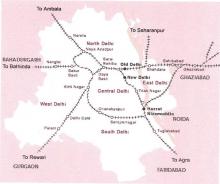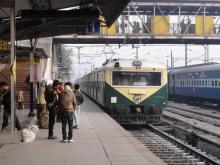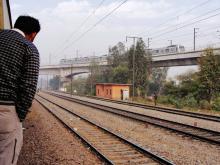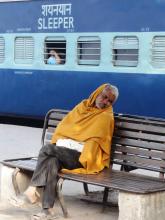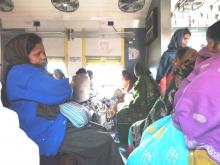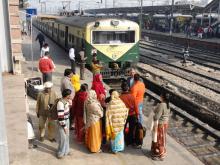This article by Warren Miller first appeared in Vol. 2, No. 2 of The Rail Enthusiast
Getting up early on a Sunday to take a trip on the Delhi ring railway! I wake at 6.30 and tumble downstairs for an early breakfast at the Ajanta hotel. Then off on an auto-rickshaw to Nizamuddin station in South-East Delhi. Being Sunday morning, the roads are quiet, and the wide, sweeping streets (I’d like to call them boulevards) are seen to their best advantage, a far cry from the jostling weekday traffic.
Why seek out an obscure railway trip, which will be neither especially scenic nor comfortable? Perhaps because it takes you off the beaten track in Delhi and the service is likely to disappear in the future. The Delhi ring railway was an early project to support urban transport for Delhi’s growing population. Built to link up several of Delhi’s major railway stations, and provide a loop around the city, it was similar in concept to the Petit Ceinture in Paris, or the North London railway in the UK, and like those, the demand for its services has dwindled. In fact, it was never a real success, being for the most part away from major population centres and poorly connected to feeder buses. Indian Railways provide several services around the ring on weekdays, but on a Sunday the only service is train 64091 at 8.00 a.m. which starts from, and finishes, at Hazrat Nizamuddin station. It runs nearly empty for most of its circuit.
Thus, at 7.30 I’m deposited at the station (it’s hard to go anywhere in an auto rickshaw for less than 100 rupees these days). I decide that even on a Sunday, a ticket is a good idea (though it’s likely that a few of the locals will not bother with such a nicety). I feel it is likely to confuse the ticket seller if I try to buy a ticket all the way around and back to the starting station, so I buy a ticket to Pragati Maidan, the next station and the last one on the ‘ring’ – cost 2 rupees – half the price of a cup of chai. I’m a little concerned as to finding the right platform for the train, but then - “Indian Railways announce that the Parikrma EMU train number 64091 will shortly arrive at platform 1”. It’s almost too easy. At platform 1, a smart looking EMU (Electric multiple unit) train pulls in ready for its journey. A handful of passengers get on unhurriedly and at 8.00 prompt, the train moves off at the start of its clockwise orbit around Delhi.
Out of Nizamuddin, the line braches east from the main southern line and heads to Lajpat Nagar. The surroundings could be called slum dwellings, though most boast satellite dishes. While not a crowded area, people are always evident, walking along the tracks or simply sitting, and always in bright colours. India is generous with contrasts: a family of foraging pigs nearby to a modern sports stadium. But perhaps only a visitor would see this as a contrast. The stations were all built with large long platforms, but on a Sunday morning they are deserted. The ring railway also carries freight traffic, as a connection between the many main lines in and out of Delhi, and this will continue to be a major function, even if passenger services around the ring are terminated. Numerous heavy freights are passed, hauled by robust-looking electric locos.
We pass through Lodi Colony station, near, but not really near enough, to the popular Lodi Gardens. No one gets on or off. At Safdarjung, we sweep past a stabled luxury train, the Rajasthan Tourist train, taking a rest from ferrying tourists to the palaces and forts of Rajasthan. Here we are skirting around the diplomatic enclave of Delhi, but discrete walls and many trees shield the embassies from the eyes of train travellers. Shortly after, at Chanakyapuri, a mysterious overgrown siding leads off through a gate, to the splendid railway museum. And on, through leafy cuttings, punctuated by mounds of rubbish, with bird calls heard above the clatter of the train. The track serves as a footpath (and loo) for the residents.
The line turns northward near Sadar Patel Marg, and the station is in a rocky cutting. A road flyover at the north end is a reminder that motor traffic is growing rapidly and doubtless, outpacing the construction of new roads. After this, the surroundings become quite rural, and the train gains a respectable speed. It’s short lived, however, and at Brar Square a sizeable group of well dressed ladies get on. Heading for the markets? Who knows, but they liven up the carriage. At Inderpuri, the platform has morphed into a small village, with squatters’ residences, washing lines, etc. In truth, Inderpuri was only a halt, so I doubt if any travellers have been inconvenienced by this. From here on the train is much busier, and Naraina Vihar and Kirti Nagar are stations that generate some traffic, almost a crowd in fact, but everyone gets a seat. We pass under the New Delhi Metro before Patel Nagar, and as if to mock the ring railway train, a metro train sweeps overhead on a new flyover. If the ring railway never quite met its objectives, the Delhi Metro has been a runaway success.
Shakurbasti station could be far from Delhi – it has all the atmosphere of a rural station; spacious platforms, shady trees, food and chai vendors, and passing mainline trains. On a siding in the bushes, an ancient 6-wheel hand cranked crane slowly rusts way, forgotten by the railway administrators. 10 minutes are allowed here as the train reverses direction for its return via North Delhi. The driver and guard amble along the platform to take up their new posts. Heading back into Delhi, via Dayabasti, it’s seen that the squatters along the line have found a practical use for adjacent barbed wire fencing – clothes lines, and no pegs are needed!!! The train empties out at Sadar Bazaar and the platform is briefly busy as people disperse toward their Sunday morning recreations and markets. By now the train is somewhat behind its timetable, about 20 minutes late, but no-one takes this train to be anywhere on time, certainly not on a Sunday.
Train number 64091 trundles through New Delhi main station, almost trying to slip un-noticed among the comings and goings of mainline trains to all parts of India. Then the colonnades of Connaught Place are sighted briefly. There’s not much of note on the final leg back to Nizamuddin; a new footbridge being built at Shivaji Bridge, a glimpse of the back of Humayun’s tomb, and then almost immediately the train is back where it started from. The 90-minute timetable has stretched to nearly 2 hours, but it’s time well spent, enjoying an informal look at the more mundane aspects of Delhi and enjoying the ambience of a leisurely and little known train service that may not continue much longer.

